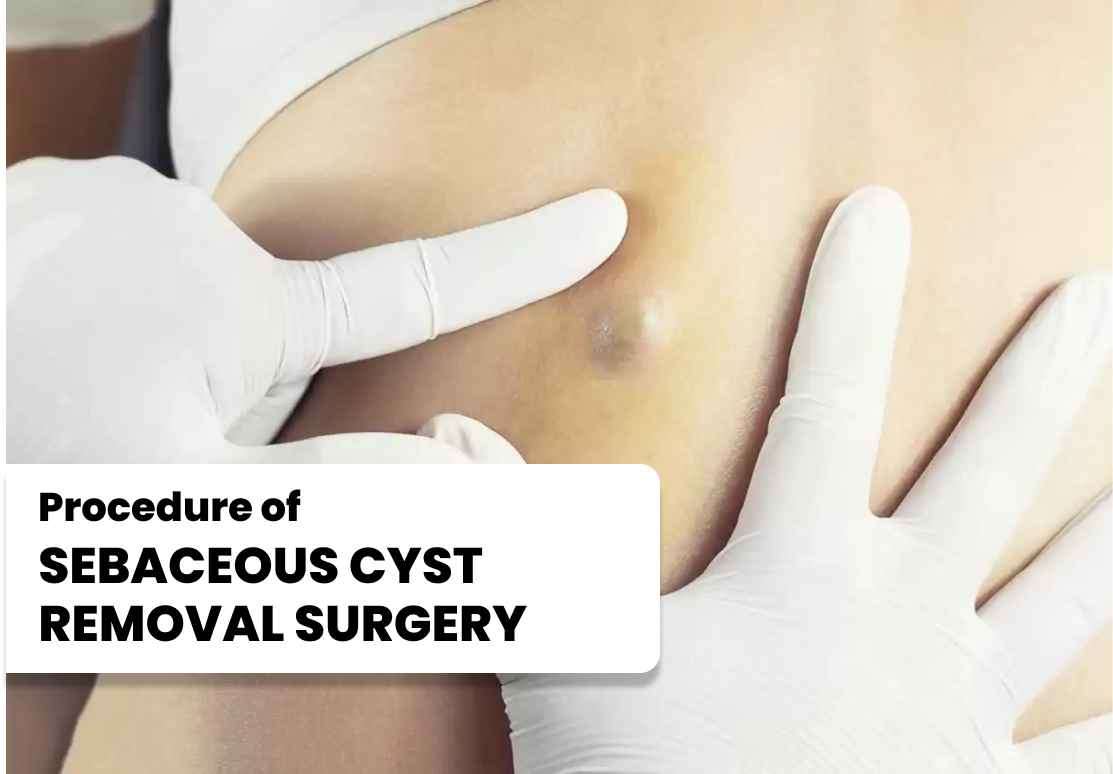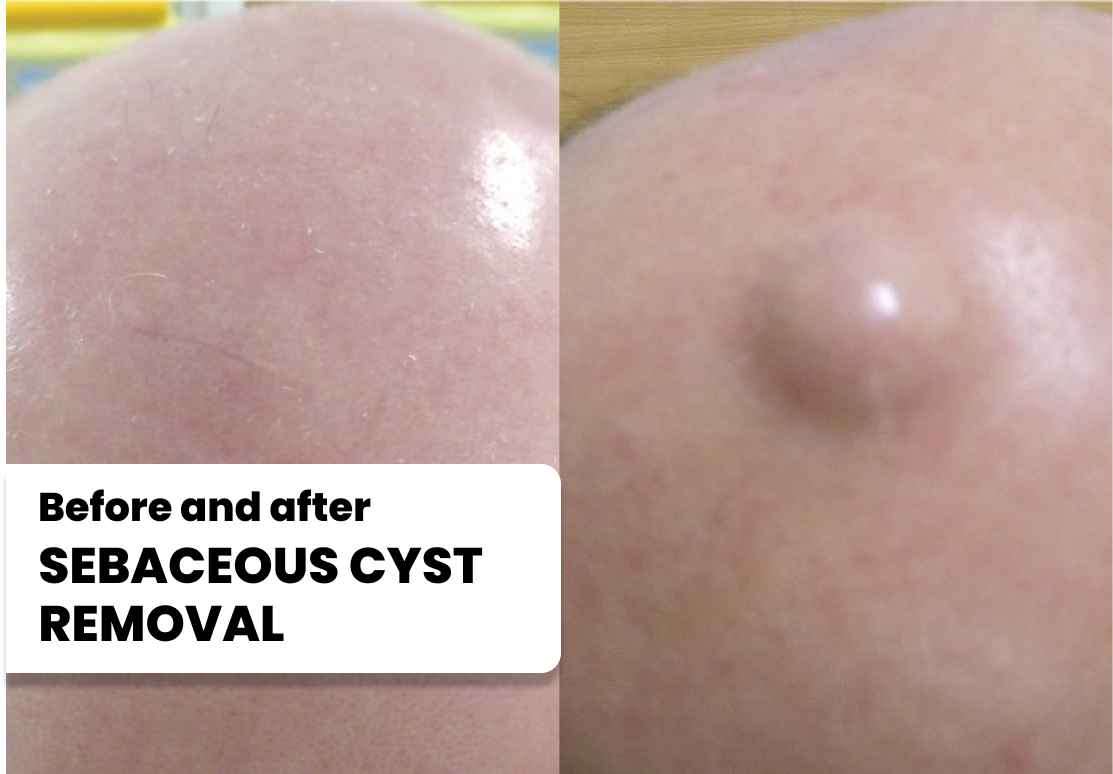Sebaceous cyst removal is a surgical procedure performed to remove a
sebaceous cyst, which is a non-cancerous, fluid-filled sac that forms
beneath the skin.
Call us to book an appointment with the best Surgeon near you.
While it may be tempting to do an epidermoid cyst removal at home, it is strongly advised against doing so. DIY removal can lead to infection, scarring, and incomplete removal of the cyst, increasing the chances of recurrence. It is always recommended to seek professional medical advice and have the cyst removed by a qualified healthcare provider.
Epidermoid cyst removal surgery is a minor surgical procedure performed by a dermatologist or a surgeon. The procedure typically involves the following steps: 2. Incision and Drainage: The surgeon makes a small incision over the cyst using a sterile scalpel or lancet. This incision allows the cyst contents to be drained. 3. Cyst Wall Removal: After the cyst is drained, the surgeon carefully removes the entire cyst wall to prevent recurrence. In some cases, a small section of the wall may be sent for laboratory testing to confirm the diagnosis. 4. Closure: The incision is closed with sutures or adhesive strips, depending on the size and location of the cyst. In certain situations, the wound may be left open to heal on its own. 5. Dressing and Aftercare: A sterile dressing is applied to the incision site to protect it from infection and promote healing. The surgeon will provide instructions on how to care for the wound at home.

Epidermoid cyst removal surgery is a minor surgical procedure performed by a dermatologist or a surgeon. The procedure typically involves the following steps: 2. Incision and Drainage: The surgeon makes a small incision over the cyst using a sterile scalpel or lancet. This incision allows the cyst contents to be drained. 3. Cyst Wall Removal: After the cyst is drained, the surgeon carefully removes the entire cyst wall to prevent recurrence. In some cases, a small section of the wall may be sent for laboratory testing to confirm the diagnosis. 4. Closure: The incision is closed with sutures or adhesive strips, depending on the size and location of the cyst. In certain situations, the wound may be left open to heal on its own. 5. Dressing and Aftercare: A sterile dressing is applied to the incision site to protect it from infection and promote healing. The surgeon will provide instructions on how to care for the wound at home.
In certain cases, non-surgical treatments may be attempted before opting for sebaceous cyst removal surgery. These options include: 1. Intralesional Corticosteroid Injections: Injecting a corticosteroid medication directly into the cyst can reduce inflammation and promote shrinkage. However, this method is not always effective, and the cyst may recur. 2. Watchful Waiting: If the cyst is small, painless, and not causing any cosmetic concerns, your healthcare provider may recommend monitoring it without immediate intervention. However, regular check-ups are necessary to ensure the cyst does not grow or become infected.

In certain cases, non-surgical treatments may be attempted before opting for sebaceous cyst removal surgery. These options include:
1. Intralesional Corticosteroid Injections: Injecting a corticosteroid medication directly into the cyst can reduce inflammation and promote shrinkage. However, this method is not always effective, and the cyst may recur.
2. Watchful Waiting: If the cyst is small, painless, and not causing any cosmetic concerns, your healthcare provider may recommend monitoring it without immediate intervention. However, regular check-ups are necessary to ensure the cyst does not grow or become infected.
If a sebaceous cyst becomes infected, prompt medical attention is necessary. Infections can cause increased pain, redness, swelling, and the formation of abscesses. Infected cysts may require drainage and antibiotic treatment to resolve the infection before considering surgical removal.

If a sebaceous cyst becomes infected, prompt medical attention is necessary. Infections can cause increased pain, redness, swelling, and the formation of abscesses. Infected cysts may require drainage and antibiotic treatment to resolve the infection before considering surgical removal.
Before the surgery, it is important to inform your healthcare provider about any medications, allergies, or underlying medical conditions you have. They will provide specific instructions on preparing for the procedure, which may include avoiding certain medications or fasting for a specified period. After sebaceous cyst removal surgery, it is crucial to follow the post-operative care instructions provided by your healthcare provider. This may involve keeping the wound clean and dry, changing dressings regularly, avoiding strenuous activities, and taking any prescribed medications. Most patients can resume their normal activities within a few days, but it may take several weeks for the wound to fully heal.

Before the surgery, it is important to inform your healthcare provider about any medications, allergies, or underlying medical conditions you have. They will provide specific instructions on preparing for the procedure, which may include avoiding certain medications or fasting for a specified period.
After sebaceous cyst removal surgery, it is crucial to follow the post-operative care instructions provided by your healthcare provider. This may involve keeping the wound clean and dry, changing dressings regularly, avoiding strenuous activities, and taking any prescribed medications. Most patients can resume their normal activities within a few days, but it may take several weeks for the wound to fully heal.
A sebaceous cyst, also known as an epidermoid cyst, is a closed sac beneath the skin that contains a semi-solid material, usually keratin. These cysts form from blocked hair follicles or oil glands, leading to the accumulation of sebum, dead skin cells, and other substances. Sebaceous cysts are commonly found on the face, neck, back, and genital areas, but they can develop anywhere on the body.

A sebaceous cyst, also known as an epidermoid cyst, is a closed sac beneath the skin that contains a semi-solid material, usually keratin. These cysts form from blocked hair follicles or oil glands, leading to the accumulation of sebum, dead skin cells, and other substances. Sebaceous cysts are commonly found on the face, neck, back, and genital areas, but they can develop anywhere on the body.
1. Local Anesthesia: Before the surgery
begins, the area around the cyst is numbed with a local anesthetic to minimize
discomfort during the procedure. 2. Incision and Drainage: The surgeon makes a
small incision over the cyst using a sterile scalpel or lancet. This incision
allows the cyst contents to be drained. 3. Cyst Wall Removal: After the cyst is
drained, the surgeon carefully removes the entire cyst wall to prevent
recurrence. In some cases, a small section of the wall may be sent for
laboratory testing to confirm the diagnosis. 4. Closure: The incision is closed with
sutures or adhesive strips, depending on the size and location of the cyst. In
certain situations, the wound may be left open to heal on its own. 5. Dressing and Aftercare: A sterile dressing
is applied to the incision site to protect it from infection and promote
healing. The surgeon will provide instructions on how to care for the wound at
home.

1. Local Anesthesia: Before the surgery begins, the area around the cyst is numbed with a local anesthetic to minimize discomfort during the procedure.
2. Incision and Drainage: The surgeon makes a small incision over the cyst using a sterile scalpel or lancet. This incision allows the cyst contents to be drained.
3. Cyst Wall Removal: After the cyst is drained, the surgeon carefully removes the entire cyst wall to prevent recurrence. In some cases, a small section of the wall may be sent for laboratory testing to confirm the diagnosis.
4. Closure: The incision is closed with sutures or adhesive strips, depending on the size and location of the cyst. In certain situations, the wound may be left open to heal on its own.
5. Dressing and Aftercare: A sterile dressing is applied to the incision site to protect it from infection and promote healing. The surgeon will provide instructions on how to care for the wound at home.
1. Intralesional Corticosteroid Injections:
Injecting a corticosteroid medication directly into the cyst can reduce
inflammation and promote shrinkage. However, this method is not always
effective, and the cyst may recur. 2. Watchful Waiting: If the cyst is small,
painless, and not causing any cosmetic concerns, your healthcare provider may
recommend monitoring it without immediate intervention. However, regular
check-ups are necessary to ensure the cyst does not grow or become infected.

1. Intralesional Corticosteroid Injections: Injecting a corticosteroid medication directly into the cyst can reduce inflammation and promote shrinkage. However, this method is not always effective, and the cyst may recur.
2. Watchful Waiting: If the cyst is small, painless, and not causing any cosmetic concerns, your healthcare provider may recommend monitoring it without immediate intervention. However, regular check-ups are necessary to ensure the cyst does not grow or become infected.

After sebaceous cyst removal surgery, it is
crucial to follow the post-operative care instructions provided by your
healthcare provider. This may involve keeping the wound clean and dry, changing
dressings regularly, avoiding strenuous activities, and taking any prescribed
medications. Most patients can resume their normal activities within a few
days, but it may take several weeks for the wound to fully heal.

After sebaceous cyst removal surgery, it is crucial to follow the post-operative care instructions provided by your healthcare provider. This may involve keeping the wound clean and dry, changing dressings regularly, avoiding strenuous activities, and taking any prescribed medications. Most patients can resume their normal activities within a few days, but it may take several weeks for the wound to fully heal.
The cost of sebaceous cyst removal surgery can vary depending on several factors, including the size and location of the cyst, the surgeon's fees, the facility charges, and any additional procedures or tests required.
Hospital/Clinic | Location | Website | Contact Number |
Apollo Hospitals | Multiple branches across India | Varies by location | |
Fortis Hospitals | Multiple branches across India | Varies by location | |
Manipal Hospitals | Multiple branches across India | Varies by location | |
Kokilaben Dhirubhai Ambani Hospital | Four Bungalows, Andheri (West), Mumbai, Maharashtra | +91-22-30999999 | |
Medanta - The Medicity | Sector 38, Gurugram, Haryana | +91-124-4141414 | |
Lilavati Hospital and Research Centre | Bandra West, Mumbai, Maharashtra | +91-22-26751000 | |
All India Institute of Medical Sciences (AIIMS) | Ansari Nagar, Aurobindo Marg, New Delhi - 110029 | +91-11-26588500 | |
Sir Ganga Ram Hospital | Old Rajinder Nagar, New Delhi | +91-11-25750000 | |
P. D. Hinduja Hospital & Medical Research Centre | Veer Savarkar Marg, Mahim, Mumbai, Maharashtra | +91-22-24449199 | |
Christian Medical College and Hospital (CMC) | Ida Scudder Road, Vellore, Tamil Nadu - 632004 | +91-416-2281000 |
Please Wait..